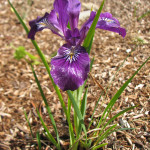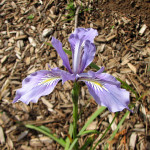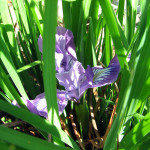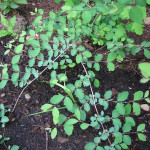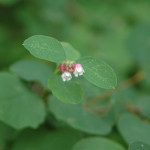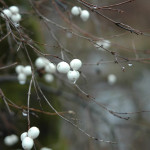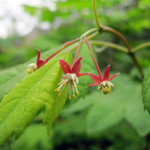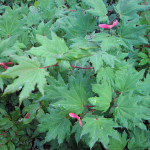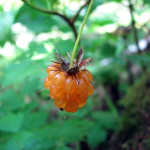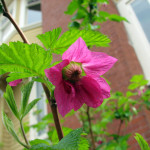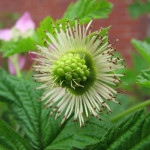Iris tenax
Iris tenax is a species of Iris native to southwestern Washington and northwestern Oregon. It is known as the tough-leaved iris or Oregon iris. It occurs along roadsides and in grasslands and forest openings at low to middle elevations. One subspecies is also known from northern California.
Like most irises, it has large and showy flowers. The flowers bloom in mid to late spring and are usually lavender-blue to purple, but blooms in white, yellow, pink, and orchid shades are known to sometimes occur.
- Light Requirements: Full Sun, Part Shade
- Water Requirements: Dry, Moist
- Ease of Growing: Moderate
- Growth Rate: Moderate
- Spreads:
- Wildlife Support: Hummingbirds, Pest-eating Insects, Birds or Mammals
- Fire-resistant: Yes
- Edible:
- Mature Height: 1-2ft
- Mature Width:1-2ft
Snowberry
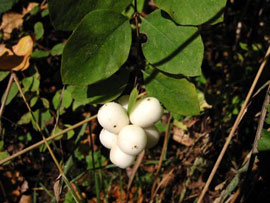
Symphoricarpos albus
Few plants are as aptly named as snowberry. Small bell-like pink flowers give way to scattered clusters of white berries in late summer, which stay on the delicate, arching branches through the fall and much of winter. The small, pale green oval leaves turn a soft yellow in the fall.
Snowberries are at their best in the landscape when combined with other plants. They bring an airy lightness to the understory that contrasts well with the thick evergreen leaves of salal and low Oregon grape, the red stems of red osier dogwoods, and the feathery green foliage of Western hemlock and Western redcedar.
The berries are eaten late in winter by thrushes, towhees, robins, waxwings, and grosbeaks. Anna’s and rufous hummingbirds are attracted to the flowers, as are many species of native bees. Snowberry also provides food for the young of vashti sphinx moths and is generally good cover for wildlife.
Snowberry is tolerant of a wide variety of growing conditions, spreads easily, and makes an excellent addition to any garden.
- Light Requirements: Full Sun, Part Shade, Full Shade
- Water Requirements: Dry, Moist
- Ease of Growing: Easy to grow
- Growth Rate: Fast
- Spreads: Yes
- Wildlife Support: Pollinators, Hummingbirds, Pest-eating Insects, Birds or Mammals
- Fire-resistant: Yes
- Edible: No
- Mature Height: 3-6ft
- Mature Width:2-4ft
Noble Fir
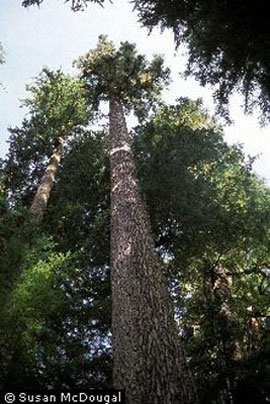
Abies procera
Noble fir (Abies procera) is native to the Cascade Range and Coast Range mountains of northwest California, western Oregon and western Washington.
It is a large evergreen tree typically up to 40-70 m tall and 2 m trunk diameter (rarely to 89 m tall and 2.7 m diameter), with a narrow conic crown. The bark on young trees is smooth, grey, and with resin blisters, becoming red-brown, rough and fissured on old trees. The glaucous blue-green needle-like leaves are 1-3.5 cm long. They are arranged spirally on the shoot, but twisted slightly to curve up above the shoot. The cones are erect, 11-22 cm long; they do not fall to the ground intact, but instead ripen and disintegrate to release winged seeds in fall.
It is a high altitude tree, typically occurring at 300-1,500 m altitude, only rarely reaching tree line.
Uses
Noble Fir is a popular Christmas tree. The wood is used for general structural purposes and paper manufacture.
- Light Requirements: Full Sun, Part Shade
- Water Requirements: Moist
- Ease of Growing: Easy to grow
- Growth Rate: Moderate
- Spreads: No
- Wildlife Support: Birds or Mammals
- Fire-resistant: No
- Edible: No
- Mature Height: 250ft
- Mature Width:30ft
Vine Maple
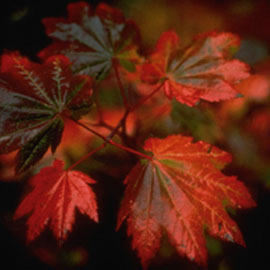
Acer circinatum
Vine maple (Acer circinatum) commonly grows as a large open shrub or small tree reaching 10-25 feet tall. It typically grows in the shady forest understory but is sometimes found out in the open. Like many plants, it typically gets taller in the shade and stays more compact in the sun.
Like all maples, the branches and leaves grow in pairs off the stem, known as “opposite branching.” Leaves are 3-14 cm long and broad, and thinly hairy on the underside. They are palmately lobed with 7-11 lobes, which are pointed with coarsely toothed margins. The flowers make a small but dramatic show in spring, blooming a bright red and whitish-green from May – June. The fruit is a two-seeded winged fruit called a samara, starting green then turning reddish-brown as they ripen. The leaves turn bright yellow to orange-red in fall and provide some of our most vivid native fall color.
Vine maples are important trees for wildlife. They provide nesting sites and cover for many birds and mammals. Vireos weave basket-like nests that hang in the forks of the branches. Birds use the seed stalks and leaves for nest building. Squirrels, chipmunks and birds eat the seeds, and the caterpillars of the brown tissue moth and Polyphemus moth forage on the leaves.
Vine maple grows best in part shade and moist soils. It can live out in the open but exposed leaves may burn and turn reddish in the afternoon sun. This is a beautiful specimen plant for a shady corner, or a tall screen to soften the side of a house. Pair it with snowberry and ferns for year-round interest.
- Vine maple is fire-resistant – remember, though, being fire-resistant does not mean it will not burn!
- Light Requirements: Full Sun, Part Shade, Full Shade
- Water Requirements: Moist
- Ease of Growing: Easy to grow
- Growth Rate: Moderate
- Spreads: No
- Wildlife Support: Pollinators, Pest-eating Insects, Birds or Mammals
- Fire-resistant: Yes
- Edible: No
- Mature Height: 20-25ft
- Mature Width:15-20ft
Oregon Ash
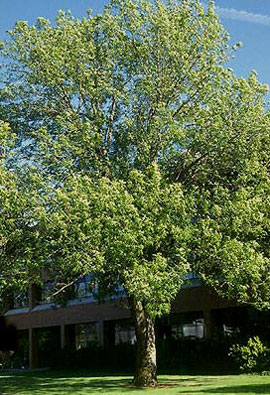
Fraxinus latifolia
Note: Due to the recent arrival of emerald ash borer in Oregon, ash trees in our region are at high risk of mortality over the next several decades. See OSU Extension Service’s emerald ash borer resources page for more information about how you can slow the spread and protect your ash trees.
* * *
Oregon ash is native to western North America on the west side of the Cascade Range from southwestern British Columbia south through western Washington and western Oregon to central California.
It can grow to 80 ft in height, with a trunk diameter of 3ft. The leaves are pinnate, 3.5-10″ long, with 5-9 ovate leaflets. The fruit is a samara, 3-5 cm long including the wing. The leaves turn a striking yellow in the fall.
Oregon ash prefers damp, loose soils, and grows from sea level to 900 meters. It is a dominant tree in local forested wetlands, paired with an understory of spiraea and slough sedge.
Oregon ash is an ideal deciduous tree to plant along streams, seeps, and wet areas. It forms an attractive shape, tolerates saturated soils, and shades waterways.
- Light Requirements: Full Sun, Part Shade
- Water Requirements: Moist, Seasonally Wet
- Ease of Growing: Easy to grow
- Growth Rate: Moderate
- Spreads: No
- Wildlife Support: Birds or Mammals
- Fire-resistant: Yes
- Edible: No
- Mature Height: 70ft
- Mature Width:25ft
Deer Fern
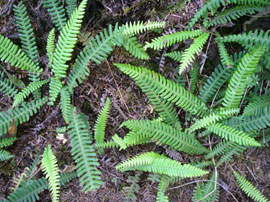
Blechnum spicant
Blechnum spicant is a species of fern known by the common names deer fern or hard fern. It is native to Europe and western North America. Like some other Blechnum it has two types of leaves. The sterile leaves have flat, wavy-margined leaflets, while the fertile leaves have much narrower leaflets. Deer fern is a major understory plant in most moist coniferous forests in our region.
- Light Requirements: Part Shade, Full Shade
- Water Requirements: Moist, Seasonally Wet
- Ease of Growing: Moderate
- Growth Rate: Slow
- Spreads: No
- Wildlife Support: Birds or Mammals
- Fire-resistant: Yes
- Edible: No
- Mature Height: 1-3ft
- Mature Width:2ft
Salmonberry

Rubus spectabilis
Salmonberry (Rubus spectabilis) is an upright shrub growing to 10 feet tall, with a unique vase-like shape and prickly stems. The purple-magenta flowers bloom April through June. The orange-red, raspberry-like fruit matures in late summer to early autumn.
Salmonberry is a great wildlife plant for a large yard or garden; the open flowers attract bumblebees and hummingbirds while the fruit is a treat for thrushes, tanagers, finches, and wrens. Native bees also use it extensively for nesting material and winter shelter.
Salmonberries grow in moist forest openings and stream margins, so it does best in full sun to part shade and moist to wet soils. They often form large thickets, and thrive in the open spaces under stands of red alder.
- Light Requirements: Full Sun, Part Shade, Full Shade
- Water Requirements: Moist, Seasonally Wet
- Ease of Growing: Easy to grow
- Growth Rate: Moderate
- Spreads: Yes
- Wildlife Support: Pollinators, Hummingbirds, Pest-eating Insects, Birds or Mammals
- Fire-resistant: No
- Edible: Yes
- Mature Height: 4-10ft
- Mature Width:4-10ft
Willamette Valley Ponderosa Pine
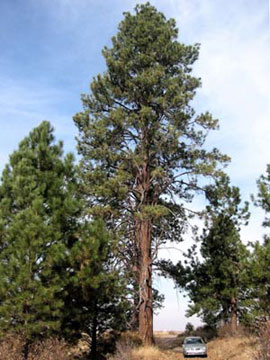
Pinus ponderosa
Willamette Valley Ponderosa Pine (Pinus ponderosa var. benthamiana) is a beautiful tree with long needles and attractive bark. Like all ponderosas, the bark of this tree has a vanilla-like scent when warmed by the sun–and they love sunny spots! However, the Willamette Valley Ponderosa is the only variety of ponderosa that can also withstand the heavy wet winter soils of our region.
This long-lived tree is very valuable for wildlife. Its needles are the only known food for gelechiid moth (Chionodes retiniella) caterpillars. Many species of birds and small mammals eat the nutritious seeds and use the needles for nesting material; others use cavities and branches for nesting and shelter.
Willammette Valley Ponderosa Pine is one of four different varieties of Ponderosa Pine, each adapted to different climatic conditions and with differing botanical characteristics. When planting in Multnomah County, it is very important to use this variety, as it is the only one that will thrive in our region.
- Light Requirements: Full Sun
- Water Requirements: Dry
- Ease of Growing: Easy to grow
- Growth Rate: Fast
- Spreads: No
- Wildlife Support: Pest-eating Insects, Birds or Mammals
- Fire-resistant: Yes
- Edible: No
- Mature Height: 150-200ft
- Mature Width:25-30ft


